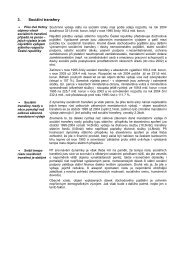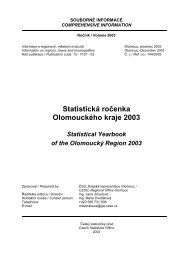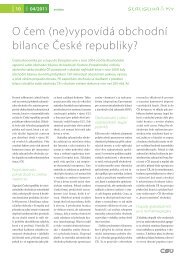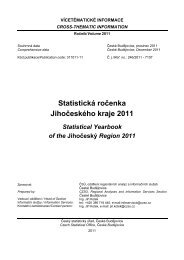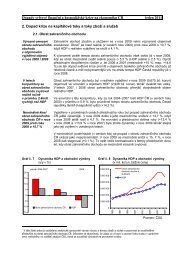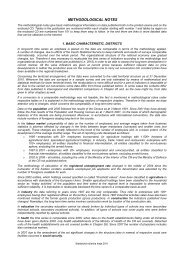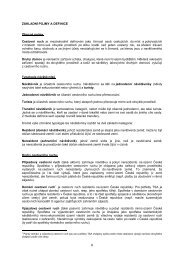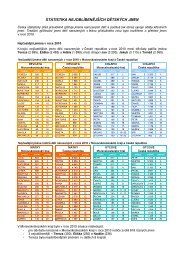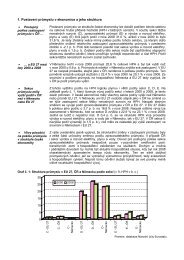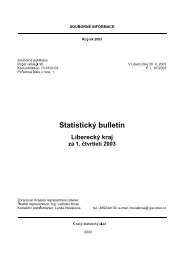Statistická ročenka Olomouckého kraje 2011 - Český statistický úřad
Statistická ročenka Olomouckého kraje 2011 - Český statistický úřad
Statistická ročenka Olomouckého kraje 2011 - Český statistický úřad
Create successful ePaper yourself
Turn your PDF publications into a flip-book with our unique Google optimized e-Paper software.
Reporting units in the R&D statistical survey are all legal and natural persons conducting R&D on the territory of<br />
the Czech Republic as their principal (Industrial Classification of Economic Activities 73; since 2008 CZ-NACE 72 –<br />
places of research) or secondary economic activity, irrespective of the number of their personnel, sector, or CZ-NACE<br />
activity they are active in. The regional breakdown of data by region has been available since 2001 and is processed<br />
by the location of the R&D workplace of respective reporting unit. Estimates of data for districts were created by locations<br />
of the economic entities and addresses of R&D workplaces in 2010. The registered office (seat) of a business may not<br />
be identical with the workplace address (location where R&D is performed).<br />
R&D personnel by occupation are:<br />
o researchers: professionals engaged in or managing projects that include the concept or generation of new<br />
pieces of knowledge, products, processes, methods, and systems;<br />
o technicians and equivalent staff (hereinafter as “technicians”) who participate in R&D activities by performing<br />
scientific and technical tasks, applying concepts and operating methods (usually under the supervision of<br />
researchers);<br />
o<br />
other research and development personnel participating or involved in R&D activities (as craftsmen,<br />
secretaries, and clerks.<br />
The registered number of employees (headcount) as at 31 December refers to registered number of active R&D<br />
personnel employed (full or part-time) at the end of the reference year irrespective of time devoted to research and<br />
development activities. Mainly in the high education and partially also in government sector, big amount of persons<br />
working in R&D, especially researchers, works for more entities and therefore in these sectors the indicator is<br />
overestimated and does not show the real number of persons working in R&D. The average registered number of<br />
employees adjusted as full-time equivalent (FTE) devoted to research and development activities brings<br />
information about real time devoted to research and development activities. One FTE is equal to one year of work fully<br />
devoted to R&D full time of an employee fully dedicated to R&D activities.<br />
Expenditure on research and development represents total expenditure (current and capital expenditure) dedicated to<br />
own research and development carried out within the reporting unit or the economic sector irrespective of the source of<br />
funds. Expenditure incurred outside the reporting unit (external expenditure on R&D) is included in the total expenditure<br />
only on condition that it directly serves to support own R&D (e.g., purchase of supplies for R&D). Data on the state<br />
support of research and development result from information contained in the R&D Information System (secretariat of the<br />
R&D Council) and in the closing account of the state budget of the CR for the area of R&D (Ministry of Finance of the<br />
CR).<br />
Data on patents were processed on the basis of data sources of the Industrial Property Office of the Czech Republic<br />
(IPO CR), which is responsible for the patent protection in the Czech Republic. The patent data are classified according<br />
to the methodology of the OECD Patent Statistics Manual (OECD, Paris, 2009).<br />
The data source for the number of scientists and engineers is the Labour Force Sample Survey (LFSS), in which<br />
basic reporting units are individuals and households. Data in tables are annual averages. If the figure is smaller than<br />
3 000 persons data are considered to be of low reliability. In 2010, there was a change in methodology and therefore<br />
data for 2010 are not fully comparable with those of previous years.<br />
Data on wages of scientists and engineers are from results of the structural statistics on wages of employees published<br />
by the Czech Statistical Office in cooperation with the Ministry of Labour and Social Affairs of the CR. The amount of<br />
average monthly gross wage of scientists and engineers given here relates solely to the survey sample (approx.<br />
1.7 million employed persons) that means the data are not grossed up.<br />
Higher education students (ISCED levels 5A and 6) in the fields of science (life sciences, physical sciences,<br />
mathematics and statistics, computing) and engineering, manufacturing and construction (engineering and<br />
engineering trades, manufacturing and processing, architecture and building) are defined in the International Standard<br />
Classification of Education - ISCED 97 (ISCED broad groups 4 and 5).<br />
High-tech goods are goods produced mainly in technology intensive operations. At the same time, development of such<br />
products is accompanied by high costs either for innovation and/or for research and development. For the needs of<br />
external trade statistics, high-tech goods are defined by the Standard International Trade Classification (SITC); they are<br />
broken down by nine groups (electronics -telecommunications, electrical machinery, pharmacy, chemistry, aerospace,<br />
non-electrical machinery, scientific instruments, computers - office machines, and armament).<br />
20. EDUCATION<br />
Data on education are taken from the database of the Institute for Information on Education, which is the workplace for<br />
the education statistics under the Ministry of Education, Youth and Sports of the CR. Tables include all schools enlisted<br />
in the register of schools and school facilities regardless their founder. Teachers (including directors and their deputies,<br />
educational consultants, and professional training teachers) are given as full-time equivalent employees.<br />
The International Standard Classification of Education (ISCED) was developed and issued by UNESCO as early as<br />
1976 to be used as a tool appropriate for collecting, processing, and disseminating of the education statistics both in<br />
respective countries and on the international scale. The last revision of the ISCED was carried out in 1997. The<br />
classification uses 7 levels of education (0 to 6), which can be each broken further internally to groups from A to C.<br />
Nursery schools provide pre-school education. Data on nursery schools include both “common” nursery schools and<br />
also schools that are especially established for children with special educational needs (hereinafter as the SEN).<br />
<strong>Statistická</strong> <strong>ročenka</strong> <strong>Olomouckého</strong> <strong>kraje</strong> <strong>2011</strong> 201



